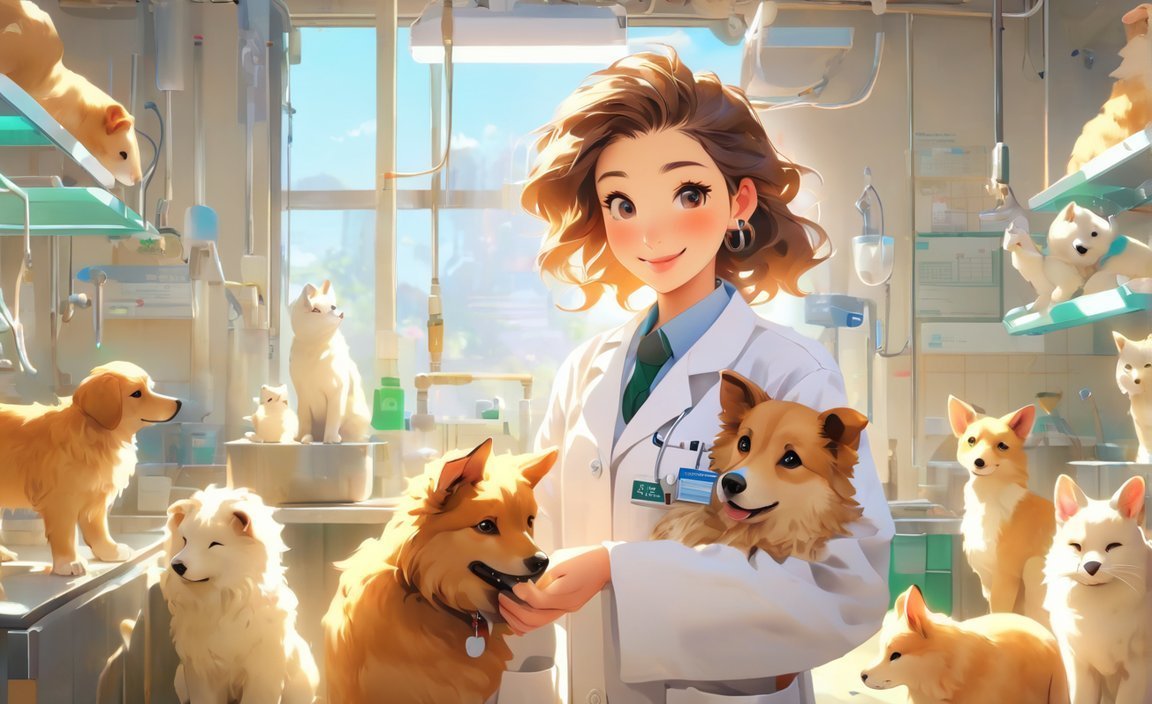Curious about what it’s like to be a veterinarian? In this article, we’re going to delve into 10 fascinating facts about being a veterinarian. From the joys of saving furry lives to the challenges of diagnosing complex ailments, we’ll uncover the rewarding and demanding aspects of this noble profession. So, whether you’re considering a career as a veterinarian or simply interested in learning more about the field, let’s explore the remarkable world of veterinary medicine together.

Key Takeaways:
- The term veterinarian, derived from the Latin word veterinae, refers to professionals who work with animals.
- Dogs are the most commonly treated animals by veterinarians due to the large number of households owning them in the United States.
- The majority of practicing veterinarians are female.
- Veterinarians often specialize in areas such as surgery, dentistry, or pathology.
- Many veterinarians develop a passion for animals early in life.
- Veterinarians must complete a four-year undergraduate degree and a four-year Doctor of Veterinary Medicine degree.
- Veterinarians play a role similar to detectives, diagnosing and treating various conditions and diseases in animals.
- Veterinarians have the ability to treat a wide array of animals, including exotic, wildlife, farm, and zoo animals.
- Diverse career opportunities for veterinarians exist in private clinics, hospitals, research facilities, government agencies, and educational institutions.
- Veterinarians promote preventive medicine by educating pet owners on how to maintain the health and prevent diseases in their animals.
- Veterinarians face emotional challenges associated with veterinary care, such as euthanasia and dealing with animal abuse.
- Veterinarians are part of a passionate community, where they share knowledge and experiences with fellow professionals and animal lovers.
10 Facts About Being a Veterinarian
Being a veterinarian is a rewarding and challenging profession that requires dedication, expertise, and a genuine love for animals. If you’re considering a career in veterinary medicine or simply curious about what it entails, here are 10 fascinating facts about being a veterinarian:
1. The term veterinarian comes from the Latin word veterinae, which means ‘working animals’.
The very origin of the word highlights the fundamentally important role veterinarians play in caring for our beloved pets and working animals alike.
2. Dogs are the most popular animals that veterinarians treat, as 46.3 million households in the United States own a dog.
Man’s best friend is a frequent visitor to veterinary clinics, making it essential for veterinarians to have expertise in canine health and wellness.
3. Almost 80% of practicing veterinarians are females.
The field of veterinary medicine is increasingly attracting women, who bring their compassion and dedication to providing excellent care for animals of all shapes and sizes.
4. Veterinarians must have a specialty, such as surgery, dentistry, or pathology.
Like human doctors, veterinarians can choose to specialize in a particular area of veterinary medicine, allowing them to develop expertise in specific treatments and procedures.
5. Most veterinarians develop a deep love for animals at a young age.
Many veterinarians cite their childhood experiences and connections with animals as the driving force behind their decision to pursue a career in veterinary medicine.
6. Veterinarians undergo rigorous education and training, including completing a four-year undergraduate degree and a four-year Doctor of Veterinary Medicine degree.
The path to becoming a veterinarian requires years of formal education, enabling them to provide the highest quality of care to our animal companions.
7. Veterinarians are like animal detectives, as they have to diagnose and treat various conditions and diseases in animals.
With their extensive knowledge and diagnostic skills, veterinarians are akin to detectives, working diligently to uncover the root causes of illnesses and provide appropriate treatments.
8. Veterinarians can treat more than just cats and dogs – they can also work with exotic animals, wildlife, farm animals, and zoo animals.
Veterinarians have the opportunity to work with a wide range of animals, from domestic pets to exotic creatures, expanding the scope and diversity of their practice.
9. Veterinarians have diverse career opportunities, including working in private clinics, hospitals, laboratories, research facilities, government agencies, or educational institutions.
The field of veterinary medicine offers a multitude of career paths, allowing veterinarians to find their niche and contribute to animal health and welfare in various settings.
10. Veterinarians are advocates for preventive medicine, as they educate pet owners on how to keep their animals healthy and prevent diseases.
Preventing disease and promoting overall wellness are vital aspects of a veterinarian’s role. They educate pet owners on preventive care measures, such as vaccinations, nutrition, and exercise, ensuring that animals lead healthy and happy lives.
Being a veterinarian is a profession rooted in compassion, knowledge, and a commitment to the well-being of animals. Through their expertise, veterinarians strive to make a positive impact on the lives of both pets and their owners, for they understand that a healthy and happy animal is a treasured member of the family.
Here are 10 fascinating facts about animal shelters that will surprise you!
- Did you know that animal shelters help save millions of animals each year? Find out more at 10 facts about animal shelters.
Discover 10 important facts about animal welfare that everyone should know!
- Learn about the efforts taken to protect and care for animals at 10 facts about animal welfare.
The Animal Welfare Council plays a vital role in ensuring the well-being of animals. Find out more with these 10 interesting facts!
- Click here to explore 10 facts about animal welfare council and learn about their important work.
Are you interested in learning fun facts about animals in Hindi? Check out these 10 interesting facts!
- Dive into the world of animals in Hindi with 10 facts about animals in Hindi.
Becoming a vet is a noble profession. Curious about what it takes? Check out these 10 captivating facts!
- Explore 10 facts about being a vet and gain insights into the rewarding world of veterinary medicine.
Did you know that box turtles are fascinating creatures? Learn 10 intriguing facts about them!
- Uncover the mysteries of box turtles with 10 facts about box turtles.
Dog sled racing is an exhilarating sport! Discover 10 exciting facts about this unique activity.
- Strap in for an exhilarating adventure and explore 10 facts about dog sled racing.
Dogs and cats are popular pets around the world. Get to know 10 intriguing facts about these beloved animals!
- Discover fascinating insights about our furry companions with 10 facts about dogs and cats.
Veterinary Career Paths and Specialties: Exploring Opportunities in Veterinary Medicine
Veterinary medicine is an incredibly diverse and fulfilling field that offers veterinarians a wide range of specialties and career paths to choose from. Whether you’re interested in becoming a general veterinarian or pursuing a specialized veterinary profession, there are numerous opportunities to make a difference in the lives of animals. In this article, we will explore the different career paths available within the veterinary field, the skills and education required, and the potential job prospects.
General Veterinarian vs. Veterinary Specialist
The first decision aspiring veterinarians face is whether to pursue a general veterinary career or specialize in a specific area. General veterinarians provide medical care to a variety of animals, including pets, livestock, and wildlife. They perform routine check-ups, diagnose illnesses, administer medications, and perform surgeries.
On the other hand, veterinary specialists undergo additional education and training to become experts in a specific field. These specialties include canine and feline practice, dairy practice, swine health management, exotic animal medicine, equine medicine, and more. Specialists often work in referral hospitals, research facilities, or academic institutions.
For more information on the different types of veterinarians and their respective specialties, check out this article on Indeed.
Career Paths in Veterinary Medicine
Veterinarians have the opportunity to work in various settings, depending on their interests and career goals. Here are some common career paths:
Private Practice: Many veterinarians establish their own clinics and serve as the head veterinarian. They provide comprehensive medical care to animals and build lasting relationships with pet owners.
Veterinary Partnerships: Joining a veterinary practice as a partner allows veterinarians to collaborate and share responsibilities with other professionals. It provides opportunities for professional growth and a diversified caseload.
Diagnostic Laboratories: Veterinarians can work in diagnostic laboratories, conducting tests and analyzing samples to diagnose diseases in animals. They play a crucial role in disease control and prevention.
Research Labs: Some veterinarians choose careers in research, working in laboratories to advance veterinary medical knowledge, develop new treatments, and improve animal health.
Government and Regulatory Agencies: The U.S. Department of Agriculture (USDA) frequently hires veterinarians for various roles. They may work in areas such as food safety inspection, animal welfare, and public health.
For a detailed breakdown of the veterinary career paths and job descriptions, visit University HQ’s comprehensive guide.
Education and Training
Becoming a veterinarian requires a Doctor of Veterinary Medicine (DVM) degree from an accredited veterinary school. Admission to veterinary school is highly competitive, and candidates must possess strong academic records, relevant experience, and a passion for animal care.
After completing the DVM program, aspiring veterinarians must pass the North American Veterinary Licensing Examination (NAVLE) to obtain a license to practice. Veterinary specialists may pursue additional education and certifications in their chosen field.
To learn more about the educational requirements and steps to become a veterinarian, check out this guide by CollegeVine.
The Rewarding Nature of the Veterinary Profession
Working as a veterinarian comes with its challenges, but it is an incredibly rewarding profession. Veterinarians have the opportunity to make a significant impact on animal health and well-being. They play a crucial role in preventing and treating diseases, improving the quality of life for animals, and promoting public health.
In conclusion, a career in veterinary medicine provides a multitude of opportunities, allowing individuals to combine their passion for animals with their desire to provide healthcare. Whether you choose to become a general veterinarian or specialize in a particular field, the veterinary profession offers a fulfilling and purposeful path.
Sources:
- University HQ – How to Become a Veterinarian
- Veterinary Healthcare Associates – Veterinary Career Path
Key Takeaways:
- Veterinary medicine offers a wide range of career paths and specialties.
- Aspiring veterinarians can choose between a general veterinary career or specialization in a specific area.
- General veterinarians provide medical care to a variety of animals, while veterinary specialists become experts in specific fields.
- Career paths in veterinary medicine include private practice, partnerships, work in diagnostic laboratories, research labs, and government/regulatory agencies.
- Becoming a veterinarian requires a Doctor of Veterinary Medicine (DVM) degree and passing the North American Veterinary Licensing Examination (NAVLE).
- The veterinary profession allows individuals to have a significant impact on animal health and well-being, and it offers a rewarding and purposeful career path.
Emotional Resilience and Compassion: Essential Qualities for Veterinarians
As a veterinarian, emotional resilience and compassion are crucial qualities that shape the way we approach our profession. It’s not just about treating animals; it’s about connecting with them and their owners on a deeper level. In this article, we will explore the significance of emotional resilience and compassion in the veterinary field and how they influence the well-being of both veterinarians and their patients.
Let’s dive into the facts that highlight the importance of emotional resilience and compassion for veterinarians:
Fact 1: Emotional Resilience Steadies the Course
Being a veterinarian is a demanding and emotionally challenging profession. We often witness animals in distress and devastating situations. Emotional resilience, the ability to bounce back from adversity, is crucial. It helps us navigate the highs and lows of our work, enabling us to provide unwavering care and support to our patients and their owners.
Fact 2: Building Emotional Resilience is Possible
While some individuals may naturally possess emotional resilience, it is a skill that can be developed and strengthened over time. With self-awareness, supportive networks, and coping strategies, veterinarians can enhance their emotional resilience, allowing them to better handle the unique challenges they face.
Fact 3: Compassion Connects Us All
Compassion lies at the heart of veterinary medicine. It is the driving force behind our commitment to provide the best care possible to every animal we encounter. Compassion fosters understanding, empathy, and a deep connection between veterinarians, animals, and their owners. It helps us make informed decisions and ensures the well-being of our patients.
Fact 4: Emotional Resilience Supports Veterinary Team Dynamics
Emotional resilience not only benefits veterinarians individually but also plays a pivotal role in fostering a supportive and cohesive team environment. By remaining emotionally resilient, we can effectively collaborate, share knowledge, and rely on our team members for support and guidance, ultimately enhancing the quality of care we provide.
Fact 5: Self-Care and Seeking Support are Essential
As veterinarians, it’s important to prioritize our own well-being to maintain emotional resilience and compassion. Consistent self-care practices, such as engaging in hobbies, seeking therapy or support groups, and taking time for personal rejuvenation, can help prevent burnout. By nurturing ourselves, we can continue to provide the best care for our furry patients.
Fact 6: Cultivating Resilience Through Mindfulness and Self-Compassion
Mindfulness and self-compassion are powerful tools that can bolster emotional resilience. By cultivating mindfulness, veterinarians can develop their ability to be present in the moment, manage stress, and navigate difficult emotions. Similarly, self-compassion encourages us to treat ourselves with kindness and understanding, enabling us to extend that same compassion to our patients and their owners.
Fact 7: Achieving a Balance between Empathy and Emotional Boundaries
While empathy is a vital quality for veterinarians, it is essential to maintain healthy emotional boundaries. Striking a balance between empathy and emotional boundaries allows veterinarians to care deeply for animals while managing emotional distress effectively. It enables us to provide compassionate care without becoming overwhelmed by the emotional toll that our work can sometimes take.
Fact 8: The Power of Emotional Regulation
Emotional regulation is an indispensable skill for veterinarians. It involves recognizing, understanding, and managing our emotions in a healthy and productive manner. By regulating our emotions, we can maintain our professional integrity, make sound judgments, and provide the best possible care for our animal patients.
Fact 9: The Ripple Effect of Compassion
Compassion extends beyond the boundaries of our clinic or hospital. When veterinarians demonstrate compassion, it influences pet owners, colleagues, and the community at large. By showing empathy, understanding, and care, we inspire others to become advocates for animal well-being and contribute to a more compassionate society.
Fact 10: Continuous Growth and Learning
Emotional resilience and compassion are qualities that veterinarians continually develop and refine throughout their careers. Through ongoing learning, self-reflection, and professional development, veterinarians can deepen their emotional resilience and compassion, ensuring the well-being of both themselves and the animals they care for.
Key Takeaways:
– Emotional resilience is paramount for veterinarians to navigate the challenges of their profession effectively.
– Compassion forms the basis of the veterinarian-animal-owner relationship, promoting understanding and empathy.
– Developing emotional resilience is possible through self-awareness, supportive networks, and coping strategies.
– Mindfulness, self-compassion, and emotional regulation strengthen emotional resilience.
– Maintaining empathy with healthy emotional boundaries ensures high-quality care without overwhelming emotional distress.
– Compassion has a ripple effect, influencing individuals and communities to advocate for animal well-being.
– Continuous growth and learning contribute to the ongoing development of emotional resilience and compassion in veterinarians.
References:
– Resilience of veterinarians at different career stages: The role of demographic and psychological factors
– Resilience in veterinary students and the predictive role of demographic and psychological factors: a cross-sectional study
– Emotional regulation in veterinary work: Do you know your comfort zone?
Being a Veterinarian can be Physically Demanding and Mentally Challenging
Being a veterinarian is an incredibly rewarding career that allows individuals to make a positive impact on the lives of animals and their owners. However, it is important to acknowledge that this profession also poses unique challenges. Veterinarians face both physical demands and mental challenges as they navigate their roles in providing essential care for animals. Let's explore some key facts about the physical and mental aspects of being a veterinarian.
Key Takeaways:
- Being a veterinarian requires physical stamina and strength to handle animals, especially larger ones, and perform tasks such as restraining them or lifting them onto examination tables.
- Veterinarians may face emotionally challenging situations, dealing with sick and injured animals, as well as communicating with distraught pet owners and helping them make difficult decisions.
Despite the challenges, many individuals find the rewards of this profession, including the opportunity to help animals, develop strong bonds with them and their owners, and make a positive difference in their lives.
Physically Demanding:
Being a veterinarian often involves physically demanding tasks. Veterinarians may need to restrain animals for examination or treatment, which can require strength and agility. In addition, handling larger animals or performing surgeries may involve lifting heavy weights. Physical stamina and endurance are essential in this profession to ensure the safety and well-being of both the veterinarian and the animals in their care.
- Mentally Challenging:
Veterinarians face a range of mental challenges throughout their careers. One of the most significant challenges is dealing with emotional situations related to animal health and welfare. Veterinarians often encounter sick or injured animals, and they must remain calm and composed while providing the necessary care. They also have to communicate with pet owners, listen to their concerns, and guide them through difficult decisions, such as end-of-life care. This emotional aspect of the profession can take a toll on a veterinarian’s well-being and requires strong emotional resilience.
- Balancing Emotional Engagement and Boundaries:
Veterinarians are deeply passionate about animals and their well-being. This passion drives their work and allows them to establish strong connections with both animals and their owners. However, it is also important for veterinarians to strike a balance between emotional engagement and emotional boundaries. They need to provide compassionate care while maintaining their ability to cope with the emotional demands of their profession. This requires self-awareness, self-care practices, and the ability to seek support when needed.
- Collaboration and Support:
Recognizing the mental challenges of the profession, the veterinary community places a strong emphasis on collaboration and support. Veterinarians often work as part of a team, including veterinary technicians, assistants, and support staff. This team-based approach allows for sharing and distributing the emotional burden of difficult cases, as well as providing encouragement and assistance. Additionally, veterinary organizations and associations offer resources and programs aimed at promoting mental health and well-being among veterinarians.
- Resilience and Self-Care:
To thrive in this profession, veterinarians need to prioritize self-care and develop strategies to maintain their mental well-being. This includes engaging in activities that promote relaxation and rejuvenation, seeking emotional and professional support, and practicing mindfulness and self-compassion. By prioritizing their own well-being, veterinarians can enhance their resilience and better cope with the challenges they face in their daily work.
Being a veterinarian is a noble and gratifying profession, but it does come with its share of physical demands and mental challenges. By acknowledging and addressing these challenges, veterinarians can ensure their own well-being and continue to provide compassionate care for animals. Remember, their dedication and love for animals drive them to overcome obstacles and make a positive difference in the lives of both animals and their owners.
Sources:
– Indeed.com. “12 Pros and Cons of Being a Veterinarian.” Available at: [^1^]
– Veterinary Practice. “Mental health and well-being in veterinary practice.” Available at:

FAQ
Q1: What is the origin of the term “veterinarian”?
A1: The term “veterinarian” comes from the Latin word “veterinae,” which means “working animals.”
Q2: What is the most common animal that veterinarians treat?
A2: Dogs are the most popular animal that veterinarians treat, with 46.3 million households in the United States owning a dog.
Q3: Are most veterinarians male or female?
A3: Almost 80% of practicing veterinarians are females.
Q4: What are the career opportunities for veterinarians?
A4: Veterinarians have diverse career opportunities, including working in private clinics, hospitals, laboratories, research facilities, government agencies, or educational institutions.
Q5: What kind of animals can veterinarians work with?
A5: Veterinarians can treat more than just cats and dogs; they can also work with exotic animals, wildlife, farm animals, and zoo animals.
- China II Review: Delicious Food & Speedy Service - April 17, 2025
- Understand Virginia’s Flag: History & Debate - April 17, 2025
- Explore Long Island’s Map: Unique Regions & Insights - April 17, 2025
















